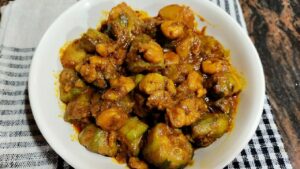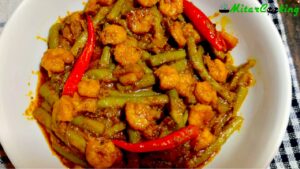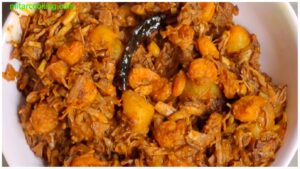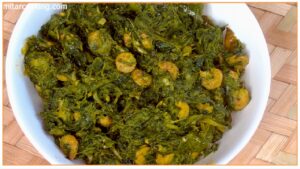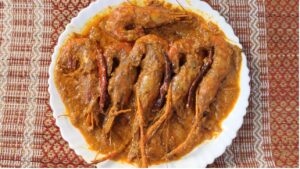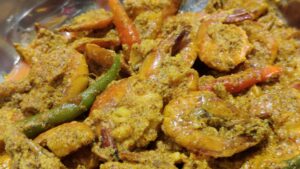If you’re craving a dish that combines the succulent taste of prawns with a rich, spicy gravy, then you’ve come to the right place.
In this recipe, I will guide you through the steps of creating a mouthwatering Prawn Masala that will leave your taste buds dancing with delight.
Prawn Masala is a popular Indian seafood dish that showcases the natural sweetness of prawns, enhanced by a harmonious blend of spices and a luscious tomato-based gravy.
It’s a dish that brings together the best of coastal flavors and traditional Indian cuisine, resulting in a tantalizing culinary experience.
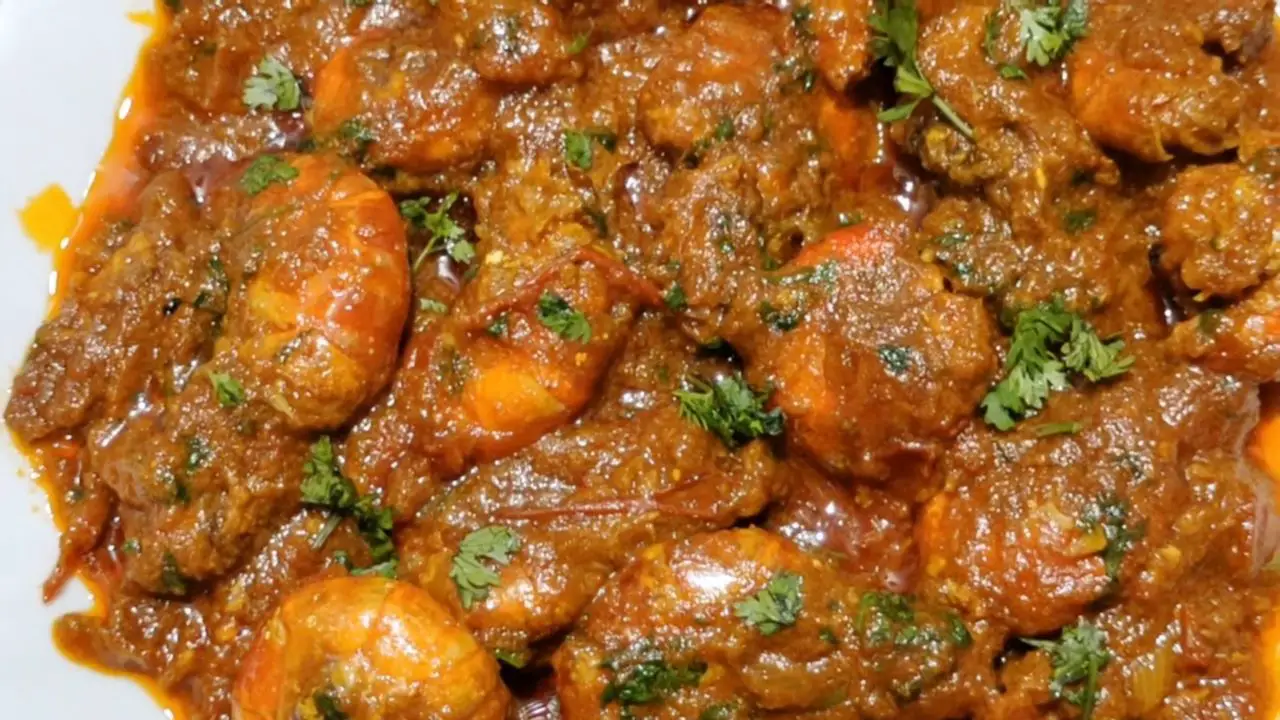
Key Takeaways:
- Prawn Masala is a popular Indian dish that features prawns cooked in a flavorful, spicy masala gravy.
- The dish involves marinating the prawns in a blend of spices, such as turmeric, red chili powder, coriander, and cumin, to enhance their flavor.
- The prawns are sautéed until they turn pink before being added to the masala gravy.
- The masala gravy is made by cooking a mixture of onions, tomatoes, ginger, garlic, and a variety of spices until it thickens and the flavors meld together.
- Prawn Masala is known for its vibrant flavors, combining layers of spices and aromatics.
- The dish can be adjusted to suit different heat levels, depending on personal preference.
- Prawn Masala is often garnished with fresh cilantro leaves for added freshness.
The Ingredients:

- Large size prawns – 600 grams (Properly deveined and cleaned)
- Onion paste (2 large size onions)
- Chopped tomato (2 large size tomatoes)
- Ginger-garlic paste – 2 tblsp
- Turmeric powder – 2 tsp
- Red chilli powder – 1 tsp
- Kashmiri Chilli Powder – 1 tsp
- Coriander powder – 1 tsp
- Cumin powder – 1 tsp
- Garam masala powder – 1 tsp
- Coriander leaves
- Mustard oil 4 tsp
- Salt to taste
How to Cook Prawn Masala (Step by Step Images)?
1. Add salt and turmeric powder to the prawns; keep them aside for 10-15 minutes.

2. Heat oil in a pan and add the prawns one by one.
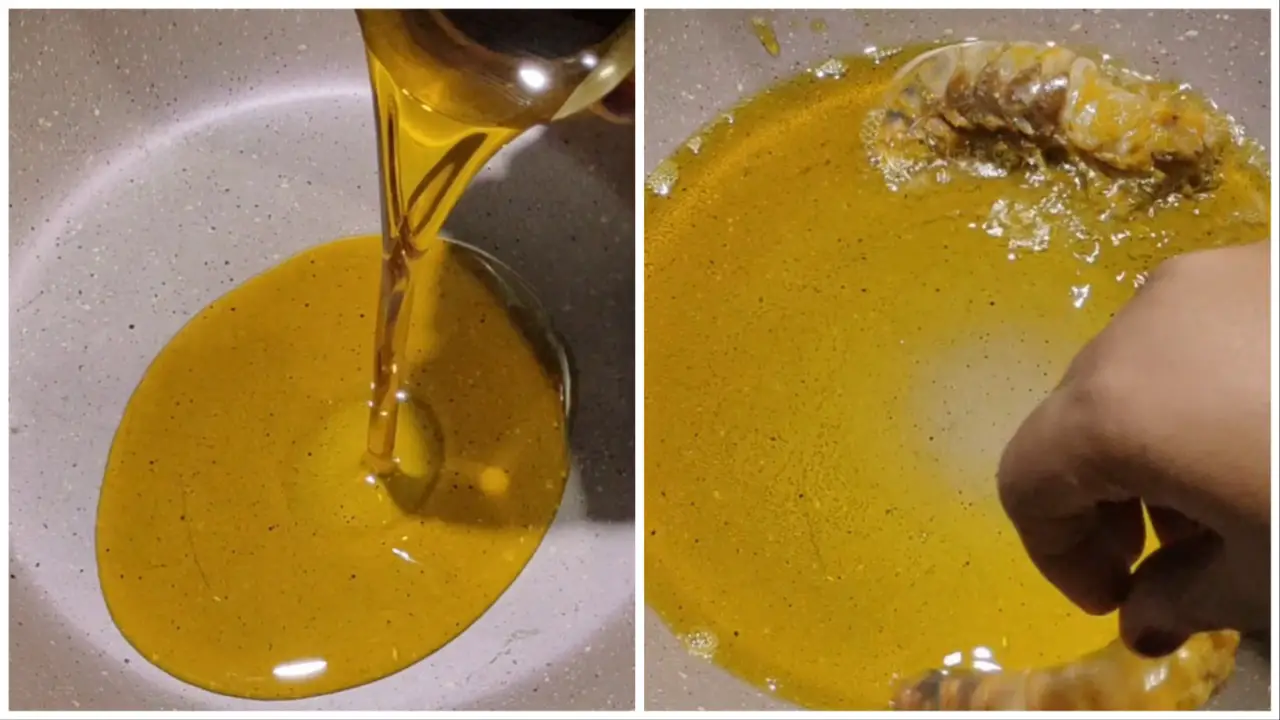
3. Fry till they turn pink. Fry them on both sides and take them out of the pan. Keep them aside.
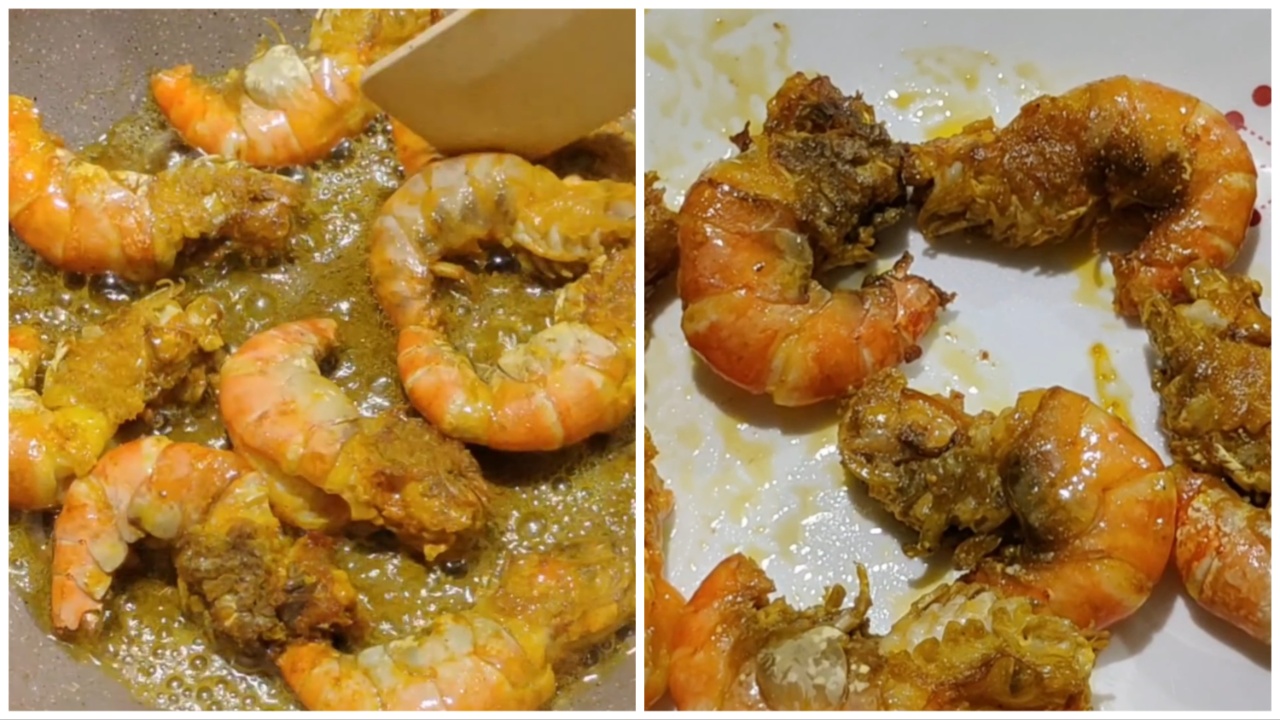
4. Add oil to the same pan (if required).

5. Add onion paste and fry till light brown.

6. Add sliced tomatoes.

7. Stir well. Add 1 tsp of salt. It will help to soften tomatoes.

8. Add ginger-garlic paste. Stir well.

9. Add turmeric powder, chilli powder, Kashmiri red chilli powder, coriander powder and cumin powder. Add a little bit of water. Add 1 tsp of salt. Mix well.

10. Add the lightly fried prawns. Mix well.

11. Sprinkle ½ tsp of garam masala powder. Give the prawns and spices a good stir.

12. Add an adequate amount of water. Let it cook for another 10 minutes.

13. After the gravy becomes thick, sprinkle chopped coriander leaves for garnishing. Serve hot.

Pro Tips for Cooking Prawn Masala
Cooking prawn masala can be a delightful experience, and here are some pro tips to help you achieve delicious results:
Choose Fresh Prawns: The quality of your prawns is crucial for a flavorful dish. Opt for fresh prawns that have a firm texture and a slightly sweet aroma. If possible, buy prawns with the shells on as they tend to have more flavor.
Marinate the Prawns: Before cooking, marinating the prawns can enhance their taste. Create a simple marinade using ingredients like lemon juice, ginger-garlic paste, turmeric powder, chili powder, and salt. Let the prawns marinate for at least 10-15 minutes to allow the flavors to penetrate.
Prepare the Masala Base: Heat oil or ghee in a pan and add aromatic spices like cumin seeds, cardamom, cinnamon, and cloves. Sauté them until fragrant to release their flavors into the oil. You can also add finely chopped onions or paste and cook until they turn golden brown, as this will impart a rich flavor to the masala.
Use Fresh Spices: For an authentic and aromatic prawn masala, use freshly ground spices instead of pre-packaged ones. Grinding whole spices such as cumin, coriander, and fennel seeds will release their oils and provide a vibrant taste.
Balance the Flavors: Prawn masala should strike a balance between spicy, tangy, and savory flavors. Adjust the spice levels by adding red chili powder, paprika, or fresh green chilies according to your preference.
Cook Prawns with Precision: Prawns cook quickly, and overcooking them can result in a rubbery texture. Add the lightly fried prawns to the masala base and cook them for another 10 minutes till the gravy becomes thick. Be mindful not to overcook them, as they can become tough and lose their natural sweetness.
Garnish with Fresh Herbs: Just before serving, garnish your prawn masala with fresh cilantro leaves (coriander) or chopped mint leaves. These herbs add a burst of freshness and bring out the flavors of the dish.
Serve Hot: Prawn masala is best enjoyed when served piping hot.
Remember, cooking is an art, and these tips can be adjusted according to your personal preferences. Feel free to experiment and make
What to Serve with Prawn Masala?
Prawn masala is a versatile dish that pairs well with a variety of accompaniments. Here are some popular options to serve alongside prawn masala:
Steamed Rice: The mild flavors of steamed rice complement the rich and spicy prawn masala. You can opt for plain white rice or fragrant basmati rice for a more aromatic experience.
Naan Bread: Soft and pillowy naan bread is a classic choice to enjoy with prawn masala. The bread’s texture and ability to scoop up the sauce make it a perfect accompaniment.
Roti or Chapati: Similar to naan, roti or chapati is another traditional Indian bread that goes well with prawn masala. These thin, unleavened breads provide a lighter option.
Paratha: Parathas are flaky, layered Indian breads made with whole wheat flour. They add a delightful texture and can be stuffed with various fillings like potatoes, paneer (Indian cottage cheese), or herbs.
Vegetable Pulao: Aromatic vegetable pulao or biryani can be an excellent choice to serve alongside prawn masala. The flavorful rice dish with mixed vegetables adds a complementary taste and texture.
Cucumber Raita: Raita is a refreshing yogurt-based side dish that helps balance the spiciness of prawn masala. Cucumber raita, made with grated cucumber, yogurt, and spices, provides a cooling contrast.
Salad: A fresh salad with greens, tomatoes, onions, and a tangy dressing can provide a refreshing contrast to the rich and spicy flavors of prawn masala.
Remember, the choice of accompaniments ultimately depends on your personal preferences and the overall meal you want to create. Feel free to mix and match to create a well-rounded and satisfying dining experience.
How Does Prawn Masala Taste?
Prawn masala is a dish that combines the flavors of succulent prawns with a rich and aromatic masala sauce. The taste of prawn masala can be described as follows:
Spicy: Prawn masala is known for its spicy flavor profile. The dish often incorporates a combination of spices such as chili powder, turmeric, cumin, coriander, and garam masala. The level of spiciness can be adjusted according to personal preference, but it typically carries a moderate to medium heat.
Savory: The masala base of the dish is made with a combination of onions, ginger, garlic, and various spices. This creates a deep and savory flavor that forms the backbone of the dish. The spices and aromatics meld together to develop a rich and robust taste.
Tangy: Prawn masala often includes an element of tanginess to balance the flavors. This can be achieved by adding a squeeze of lemon juice, tamarind pulp, or even tomatoes. The tanginess adds a refreshing and bright note to the overall taste.
Umami: Prawns themselves have a naturally sweet and slightly briny flavor. When combined with the spices and masala, it creates a harmonious umami taste. The prawns contribute a delicate seafood essence to the dish, enhancing its overall flavor profile.
Fragrant: The aromatic spices used in prawn masala contribute to its enticing aroma. The combination of spices, onions, and garlic creates a tantalizing fragrance that adds to the overall sensory experience.
The taste of prawn masala can vary depending on the specific recipe and regional variations. Some recipes may have more pronounced heat and spice, while others may focus on a well-balanced blend of flavors.
Ultimately, prawn masala offers a delicious combination of spice, savory notes, tanginess, and the natural sweetness of the prawns themselves.
Prawn Masala Alternatives
If you’re looking for alternatives to prawn masala, here are a few options that you might enjoy:
Prawn Curry: Prepare a different style of prawn curry, such as Thai red or green curry. Use a store-bought curry paste or make your own by blending herbs, spices, and aromatics. Simmer the prawns in the curry sauce along with coconut milk, vegetables, and seasonings of your choice.
Chicken Masala: Substitute prawns with boneless chicken pieces to create a flavorful chicken masala dish. The cooking process and spices can be similar to prawn masala, with adjustments made for chicken cooking times.
Fish Curry: If you prefer fish over prawns, you can make a delicious fish curry instead. Choose a firm fish variety that holds up well in curries, such as salmon, cod, or tilapia. Cook the fish in a flavorful curry sauce with spices, tomatoes, coconut milk, and herbs.
Vegetable Masala: For a vegetarian or vegan option, prepare a vegetable masala. Use a mix of seasonal vegetables like potatoes, carrots, peas, cauliflower, and bell peppers. Sauté the vegetables with spices and create a luscious masala sauce to coat them.
Paneer Masala: Paneer, a type of Indian cottage cheese, can be a great alternative to prawns. Cut the paneer into cubes and cook it in a rich and creamy masala sauce. Paneer masala pairs well with rice, naan, or roti.
Mushroom Masala: Mushroom lovers can enjoy a mushroom masala dish. Sauté mushrooms with onions, garlic, and spices until they are tender and flavorful. Finish with a tomato-based masala sauce for a satisfying vegetarian option.
Tofu Masala: For a vegan alternative, you can replace prawns with tofu. Marinate tofu cubes and cook them in a spicy and aromatic masala sauce. Tofu absorbs flavors well and can provide a delicious and protein-packed alternative.
Remember to adjust the cooking times and techniques based on the alternative ingredient you choose. The spice levels and flavor profiles can be adapted to suit your preferences.
What is Prawn Masala Called in Different Languages?
Prawn Masala is known as Chingri Masala in Bengali and Jhinga Masala in Hindi.
Recipe Card

Prawn Masala (Jhinga Masala)
Ingredients
- 600 grams Prawns (properly deveined and cleaned)
- 2 pieces Onion (freshly pasted)
- 2 pieces Tomato (chopped)
- 2 tablespoons Ginger garlic paste
- 2 tablespoons Turmeric powder
- 1 tablespoon Red chili powder
- 1 tablespoon Kashmiri Chili Powder
- 1 tablespoon Coriander powder
- 1 tablespoon Cumin powder
- 1 tablespoon Garam masala powder
- 1 tablespoon Coriander leaves (chopped)
- 4 tablespoon Mustard oil
- Salt to taste
Instructions
- Marinate the prawns: Take the prawns and sprinkle them with salt and turmeric powder. Set them aside for 10-15 minutes to allow the flavors to infuse.
- Fry the prawns: Heat oil in a pan and add the marinated prawns one by one. Fry them until they turn pink, making sure to cook both sides evenly. Once done, remove the prawns from the pan and set them aside.
- Prepare the base: If needed, add more oil to the same pan. Add the onion paste and fry it until it turns light brown. Then, add the sliced tomatoes and stir well. Sprinkle 1 tsp of salt to help soften the tomatoes. Stir in the ginger-garlic paste, ensuring everything is mixed thoroughly.
- Add spices: Now it's time to add the turmeric powder, chilli powder, Kashmiri red chilli powder, coriander powder, and cumin powder. To create a paste-like consistency, add a little water. Additionally, sprinkle 1 tsp of salt and mix everything well.
- Incorporate prawns: Return the lightly fried prawns to the pan and mix them well with the spices. Sprinkle ½ tsp of garam masala powder over the prawns and spices, giving them a good stir to distribute the flavors evenly.
- Simmer and garnish: Add an adequate amount of water to create a gravy consistency. Let the mixture simmer for another 10 minutes, allowing the flavors to meld together. Once the gravy become thick, garnish with chopped coriander leaves.
Video
Notes
Nutrition Info (Estimation Only)
Conclusion
Prawn masala goes best with steamed rice. A royal rendezvous with spice-coated prawns is always cherished on special celebrations.
It could easily be your next weekend special. Give it a shot and tell me if it is really worth your expectations.

